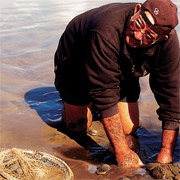Auckland to Paihia - Day One
Auckland to Paihia

Following the Twin Coast Highway, we head north. It’s a route I know well, but as this is the first of many journeys, I’m hoping that my travelling companion, Bob, will shape up to become a worthy co-pilot. As we leave Auckland’s sprawl at Orewa, uncertainty sets in. “What’s with Pie-hire?” he says jabbing his finger hopefully at Paihia, on what (in less than an hour) has fast become a crumpled page. I laugh outright; skilled navigator or otherwise, at least – if nothing else – he’s a man after my own heart when it comes to food!
And so we stop in Warkworth, where life is as mellow as the river upon which it was built. On a sunny terrace we breakfast upon eggs with vivid-yellow yolks. “Do you think they add dye?” asks Bob, sipping on his latte.
We leave town driving on through Wellsford and Kaiwaka where the concrete turrets of café Utopia signal that we’ve entered quirkier climes. At the top of the Brynderwyn Hills, Northland’s scenery begins to unfold with the fabulous panorama of Bream Bay from the jagged silhouette of Whangarei Heads to the dramatic peaks of the Hen and Chicken Islands. Bob’s still agog as we glide past Waipu and on to Ruakaka’s broad sweep of sand, dominated by Marsden Point Oil Refinery’s chimneystack.
A quick stretch of the legs - Bob deposits shells and a mottled crab’s claw into the glove box - and we drive to Longview Vineyard, where eighty-five-year old Milly Vuletich presses a tasting glass into our hands. The Vuletich family set up a self-sufficient winery in 1964, and Milly’s son, Mario, crafts its estate-grown wines and ports.
At Whangarei’s Town Basin, situated on a dock overlooking the marina, seafood chowder, full of fish and cream, is the order of the day. Later we wander past the NZ Fudge Farm’s gooey treats, a host of galleries and artists’ studios and stop outside Burning Issues to watch glass being blown.
Next we call into the spectacular Whangarei Falls, which plunge some 25 metres into a tranquil, bush-fringed pool. It’s a leisurely 20-minute hike around the falls before we rejoin SH1 and drive to Kawakawa, where we stop to bask in the sun outside the Trainspotting Café. There are no trains to speak of (even though the tracks run the entire length of the main street) and so we watch passers-by, who seem to be milling around the public loos. Our waitress, following Bob’s gaze as she sets down our teapot, kindly explains that they are the last works of renowned Austrian-born artist, Friedrich Hundertwasser.
Commissioned in 1997, Hundertwasser, who made New Zealand his home in the 1970s, encouraged locals to take part: students crafted tiles and the windows were made from old bottles found in the neighbourhood. Intrigued, Bob photographs its mosaics while I queue with camera-toting tourists for a far more prosaic purpose!
We leave and drive along Paihia’s waterfront, past families building castles in the sand, to the village proper where couples stroll hand in hand, and the squawking of gulls’ blends with laughter from its many cafés and bars.
After checking into our waterfront hotel, we enjoy an early dinner of fish and chips, seated – Paihia-style – on a park bench overlooking the water. Beady-eyed gulls observe our every move, while we in turn watch the bustling wharf from which vessels depart continuously: some ferry passengers to Russell, others carry dolphin-watchers or tour the bay’s 144 islands en route to the Hole in the Rock.
As the sun sinks slowly into a blood-red sky, we walk across a long single-lane bridge to Waitangi, where New Zealand’s founding document, the Treaty of Waitangi, was signed in 1840. By day it’s a haunt for the historically-minded; by night it’s the setting for a modern cultural production performed by a talented group of local Maori.
To Bob’s delight, our guide, Kena Alexander, chooses him to act as our honorary ‘chief’. As the light fades to dark we’re greeted by a formidable band of warriors, but Bob (quietly quaking in his shoes) holds his ground to fulfill his chiefly obligations. Formalities completed, we’re invited inside the Whare Runanga, where local tales unfold in a musical, narrated by an old Maori gentleman to his grandson. The whare depicts the ancestors of many Maori tribes in its intricate carvings including the great explorer Kupe, who landed in the Hokianga, on Northland’s west coast.
Much later, aided by a glowing moon, we make our way back to Paihia and lulled by the gentle lapping of waves, drift off to sleep.